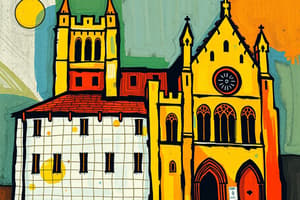Podcast
Questions and Answers
The Early Medieval period lasted from 500 to 1000 AD.
The Early Medieval period lasted from 500 to 1000 AD.
True (A)
Gothic architecture is characterized by thick walls and small windows.
Gothic architecture is characterized by thick walls and small windows.
False (B)
Romanesque architecture features barrel and groin vaults.
Romanesque architecture features barrel and groin vaults.
True (A)
Flying buttresses are a characteristic of Romanesque architecture.
Flying buttresses are a characteristic of Romanesque architecture.
Notable buildings of the Gothic period include Notre-Dame Cathedral.
Notable buildings of the Gothic period include Notre-Dame Cathedral.
Italian Gothic architecture emphasizes classical elements and ornamentation.
Italian Gothic architecture emphasizes classical elements and ornamentation.
The Romanesque style predominantly used wood for construction.
The Romanesque style predominantly used wood for construction.
The Gothic period was characterized by simple structures and minimal decoration.
The Gothic period was characterized by simple structures and minimal decoration.
Flashcards are hidden until you start studying
Study Notes
Overview of Medieval Architecture
- Timeframe: Approximately 5th to late 15th century.
- Key periods:
- Early Medieval (500-1000 AD)
- Romanesque (1000-1200 AD)
- Gothic (1200-1500 AD)
Key Characteristics
-
Early Medieval:
- Simple structures, often wooden.
- Use of Roman techniques adapted for local materials.
- Monastic buildings, castles, and churches.
-
Romanesque:
- Thick walls, small windows, and rounded arches.
- Barrel and groin vaults for ceilings.
- Use of stone for durability.
- Notable buildings: Abbey of Cluny, Durham Cathedral.
-
Gothic:
- Pointed arches, ribbed vaults, and flying buttresses.
- Large stained glass windows, creating illuminated interiors.
- Verticality and lightness in design.
- Notable buildings: Notre-Dame Cathedral, Chartres Cathedral.
Notable Architectural Features
-
Arches:
- Rounded in Romanesque; pointed in Gothic.
-
Vaults:
- Barrel vaults in Romanesque; ribbed and fan vaults in Gothic.
-
Buttresses:
- Thick, solid in Romanesque; flying buttresses in Gothic to support walls.
-
Towers and Spires:
- Tall structures in Gothic architecture symbolizing heaven.
Regional Variations
-
English Gothic:
- Emphasis on height and elaborate decoration.
- Notable examples: Westminster Abbey, York Minster.
-
French Gothic:
- Famous for the use of light and space.
-
Italian Gothic:
- More emphasis on classical elements and ornamentation.
Influence and Legacy
- Transitioned into Renaissance architecture.
- Many medieval buildings remain as cultural heritage sites.
- Influences can be seen in modern structures incorporating historical styles.
Overview of Medieval Architecture
- Timeframe ranges from the 5th century to the late 15th century.
- Major periods include:
- Early Medieval (500-1000 AD)
- Romanesque (1000-1200 AD)
- Gothic (1200-1500 AD)
Key Characteristics
-
Early Medieval:
- Featured simple, often wooden structures.
- Adapted Roman techniques to utilize local materials.
- Predominantly included monastic buildings, churches, and castles.
-
Romanesque:
- Characterized by thick walls, small windows, and rounded arches.
- Employed barrel and groin vaults to support ceilings.
- Utilized stone construction for enhanced durability.
- Notable examples include the Abbey of Cluny and Durham Cathedral.
-
Gothic:
- Defined by pointed arches, ribbed vaults, and flying buttresses.
- Large stained glass windows created illuminated and vibrant interiors.
- Emphasized verticality and a sense of lightness in design.
- Iconic structures include Notre-Dame Cathedral and Chartres Cathedral.
Notable Architectural Features
-
Arches:
- Romanesque arches are rounded; Gothic arches are pointed.
-
Vaults:
- Romanesque architecture features barrel vaults; Gothic architecture incorporates ribbed and fan vaults.
-
Buttresses:
- Romanesque structures have thick, solid buttresses; Gothic architecture introduces flying buttresses to support higher walls.
-
Towers and Spires:
- Gothic architecture includes tall towers and spires that symbolize the aspiration towards heaven.
Regional Variations
-
English Gothic:
- Noted for its emphasis on height and elaborate decoration.
- Examples include Westminster Abbey and York Minster.
-
French Gothic:
- Renowned for its innovative use of light and spatial design.
-
Italian Gothic:
- Places more emphasis on classical elements and intricate ornamentation.
Influence and Legacy
- Led to the development of Renaissance architecture.
- Many medieval buildings remain significant cultural heritage sites.
- Modern structures often incorporate elements of historical styles inspired by medieval architecture.
Studying That Suits You
Use AI to generate personalized quizzes and flashcards to suit your learning preferences.




